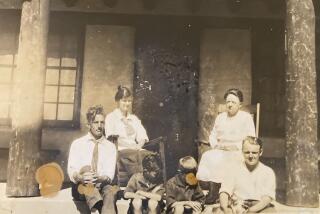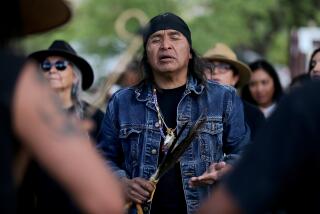Geronimo’s Memory Lives On in the Southwest : History: The most famous Apache of all was the last great Indian leader to stand against the tide of Manifest Destiny.
Even today, feelings are rarely neutral about Geronimo, the most famous Apache of all.
Holding out the longest and fighting against daunting odds, he was the last great Indian leader to stand against the tide of Manifest Destiny that pushed United States land claims steadily west.
By 1881 only the four bands of Chiricahua Apache remained free, sweeping at will across southern Arizona and New Mexico. All of the great Chiricahua chiefs were dead.
Yet for five more years, a single charismatic warrior--Geronimo--spearheaded an impossible resistance. At the end, Geronimo’s group amounted to only 16 warriors, 12 women and six children, writer David Roberts says.
Against them were deployed 5,000 U.S. troops, or one-quarter of the entire Army, and perhaps 3,000 Mexican soldiers.
Geronimo was never a chief, but rather a medicine man, a seer and a leader in battle. He was a master manipulator and an opportunist. He was naturally distrustful, a trait that Mexican and U.S. betrayals reinforced.
Sometime around 1823, Geronimo was born in what is today western New Mexico but was then Mexican territory.
His family named him Goyahkla. It was the Mexicans who began calling him Geronimo, perhaps for St. Jerome, when the knife-brandishing Goyahkla repeatedly ran through hails of their bullets and they shouted in desperation, “Geronimo!”
The pivotal event of Geronimo’s life occurred in the town of Janos, in Mexico’s Chihuahua state, where Mexican troops slaughtered his mother, wife and three children.
For the rest of his life, he hated all Mexicans. He killed them whenever he could, without pity.
In February, 1861, a young Army lieutenant brutalized Cochise and his family. “This treatment of the greatest Chiricahua chief set the Apache as bitterly against the White Eyes as they had stood for decades against the Mexicans,” Roberts said.
In 1876, four years after the federal government had established a reservation for the Chiricahua in southeast Arizona, the government ordered the Indians moved to San Carlos, Ariz.
Geronimo fled in the night with 700 men, women and children who refused to give up their freedom.
Eighty armed men captured Geronimo a year later. For two months he was held a prisoner in irons at San Carlos.
In the 1880s, with the White Eyes becoming more numerous, a still rebellious Geronimo and his band moved across the Mexican border into the Sierra Madre Mountains.
Determined to crush Geronimo for good, in May, 1883, more than 300 federal troops marched deep into the mountains, turning the tide of the war. Most of the Apache, now weary and demoralized, would never again break out from the reservation.
Geronimo, in an effort to live at peace with the White Eyes, stuck it out for a year on Arizona’s White Mountain Reservation. But tensions on the reservation were mounting.
Informed that he was about to be arrested and hanged, Geronimo left the reservation with 145 other Chiricahua in May, 1885.
On their initial dash to Mexico, the fugitives left 17 White Eyes dead. Often the victims had been mutilated.
Soon the Chiricahua wearied of their fugitive life. In March, 1886, Geronimo surrendered to Gen. George Crook. “Once I moved about like the wind,” he said. “Now I surrender to you, and that is all.”
But it wasn’t all. Again threatened with hanging, Geronimo fled south with a small group of followers.
By the end of August, the fugitives were desperate to see their families and relatives again, and on Sept. 4, Geronimo surrendered for the last time.
For their intransigent resistance, the Chiricahua were punished as no other U.S. Indians had been. All of them, even women and children, ultimately served nearly 30 years as prisoners of war, first in Florida and Alabama, then at Ft. Sill in Oklahoma.
According to those closest to him, Geronimo for the rest of his life bitterly regretted having surrendered. He wished instead that he had stayed in the Sierra Madre with his warriors, fighting it out to the last man.
On a winter night in 1909, riding home from the town of Lawton, Okla., Geronimo fell off his horse and lay in a ditch until morning. About 85 years old, he succumbed to pneumonia four days later.
More to Read
Sign up for Essential California
The most important California stories and recommendations in your inbox every morning.
You may occasionally receive promotional content from the Los Angeles Times.










